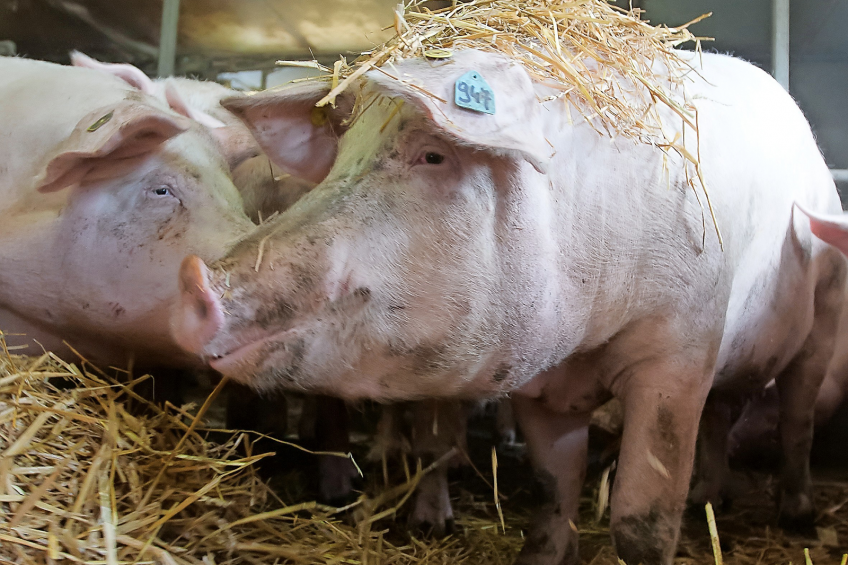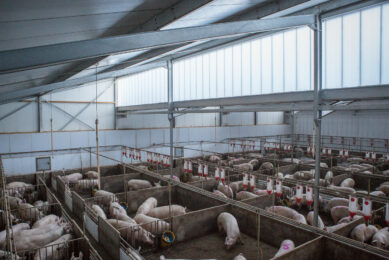What type of enrichment is best for sows?

For piglets and finishers, many enrichment materials of various sizes have been designed over the years. Now how about their mothers? What is the ideal form of distraction for them? In Canada, rope, straw, woods and chains are being observed closely while being provided to sows.
While many different forms of enrichment materials have been studied, most of the research has been done on piglets and growing pigs. Examples are:
- straw,
- chains,
- wood,
- rope,
- mushroom compost,
- wood shavings,
- garden hose,
- peat moss and
- rubber balls.
These studies have shown that, when growing pigs are given appropriate enrichments, they can benefit from reduced aggression, fewer behavioural vices (such as tail-biting), reduced fear, and improved growth. While similar benefits can be expected for sows, older animals are different and generally prefer manipulable and destructible enrichments over simple objects.
The farm-level interest in sow enrichment has been driven by the revised Canadian Code of Practice for the Care and Handling of Pigs, which includes a requirement that all pigs should be provided with ‘multiple forms of enrichment that aim to improve the welfare of the animals’. This code requirement and the increasing trend towards group gestation housing have created a need for research in this area.
Enrichment for group housed sows
Funded by Agriculture and Agri-Food Canada (AAFC) and part of a larger Swine Innovation Porc project (led by Dr Laurie Connor at the University of Manitoba, with the research being carried out at Prairie Swine Centre and the University of Manitoba), this project examines different methods of developing effective environmental enrichment for group-housed sows which would be economically viable to the pig industry and could serve to guide producers in decision making.
Use of straw as enrichment
European research has identified straw and other malleable and consumable materials as being optimal for pigs. However, in North America there is a greater reluctance to provide such materials. Straw has been shown to be effective in grower-finisher pigs, but many producers feel there may be an increased risk to biosecurity by bringing straw into their facilities. Small amounts of high fibre materials (e,g, chopped or pelletised straw) can be provided, in a rack or hopper, for example, and will increase satiety (feeding satisfaction) in sows as well as provide enrichment.
Reducing aggression and stress in sows
Providing enrichment can help to reduce aggression and stress and improve physiological function for all ages of animals, providing a direct benefit to pork producers, along with addressing public concerns regarding barren conditions in housing facilities.
Sows in stalls show stereotypies or abnormal behaviours such as bar biting, continuous drinking and vacuum/sham chewing. Stereotypies are defined as behaviours with no clear function, and are seen as indicators of frustration, boredom, fear and stress.
Sows in group housing also show some of these abnormal behaviours, especially ear/tail-biting, bar biting, as well as overt aggression, which can increase the chance of abortions.
4 treatments are being provided to sows:
- rope,
- small amounts of straw,
- wood on chains and
- a control treatment where there is no provision of enrichment materials.
Influence of social status on enrichment use
Because pigs are social animals and their social status can influence enrichment use, the effects of social status will also examined. Social status is determined in a feed competition trial whereby 6 focal sows; 3 dominants and 3 subordinates are selected for additional data collection. Mostly, in a social environment, subordinate animals are being bullied and driven away from available resources by dominant ones. Dominate and subordinate sows are selected in this study to determine if all sows, irrespective of social status, will benefit from enrichment use.
Monitoring enrichment use and success
A common problem with enrichments is that animals lose interest over time. This project will also examine if regular rotation of enrichments can increase their interest and value to sows, compared to constant provision.
Cameras are mounted over the pens and time lapse photos are taken on selected days to determine the level of enrichment use, and the activities and postures of sows. Stereotypic behaviours are recorded by live observation of sows, and levels of aggression are determined using skin lesion scores, ranging from 0 (no injury) to 3 (severe injury) on both sides of the body.
Accelerometers are used as automated measuring tools to record the mobility of animals, similar to pedometers used to record fitness activities in people. Accelerometers are being used in this research to compare the activity levels of dominant and subordinate sows. Saliva samples are also taken in the early part, mid- and end of each trial to determine cortisol levels as a measure of stress.
While the benefits of enrichment are well known, determining exactly which enrichments are suitable at each stage of production, as well as the best methods for presenting them are still unclear. This research will help to fill these gaps related to sows, and will form the basis for practical recommendations to benefit sows and help producers meet the code of practice requirement.
Enrichment is a new area for Canadian pig producers, and time is needed to clarify what is meant by enrichment and to implement these measures.
This research project will be completed in December 2017, with results available in 2018. This project is funded by Swine Innovation Porc within the Swine Cluster 2: Driving Results Through Innovation research program. Funding is provided by Agriculture and Agri‐Food Canada through the AgriInnovation Program, provincial producer organisations and industry partners.











